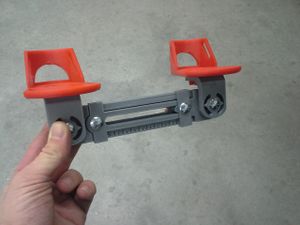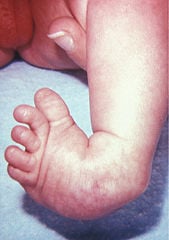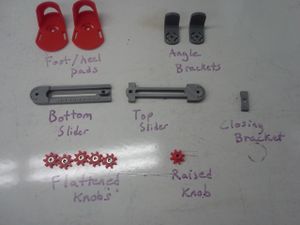
For updated version see: Open-Source Three-Dimensional Printable Infant Clubfoot Brace

Brace for the treating of infants with club foot. Club foot is a congenital, physical deformity that is characterized by infants being born with a foot turned inward or to the side. It is easily and typically treated in developing countries, but in rural, developing areas where treatment options may be less available, club foot can lead to life-long disability. It has been estimated that prevalence of clubfoot in Africa is approximately 2 in 1000 births [1] and as high as 8 in every 1000 births in East Africa [2].
This project was inspired by conversations with Kenyan orthopedics specialists that occurred in Kisumu, Kenya in 2016.
Solution[edit | edit source]

A 3D printable brace that can be used to treat children born with club foot. The brace is able to be adjusted in several different directions, can extend in stance-width, and has an open-toe design to allow for a variety of sizes. The stance widith is measurable in 0.5cm increments, and both angles can be adjusted to the nearest 15 degrees.
As with most braces used for the treating of club foot, infants and small children have their feet locked into the foot pads with straps (improvisable with cloth or velcro), and then sleep with the braces on their feet. Over time, the braces can be slowly adjusted to correct the positioning of the feet.
Bill of Materials[edit | edit source]
- PLA plastic filament
- 2 x 1/4-20 1" carriage bolt
- 1 x 1/4-20 1.25" carriage bolt
- 1 x 1/4-20 0.75" carriage bolt
- 2 x 1/4-20 1" hex head bolt
- 6 x 1/4-20 hex nut
Tools needed[edit | edit source]
- MOST Delta RepRap or similar RepRap 3-D printer
Skills and knowledge needed[edit | edit source]
None
Technical Specifications and Assembly Instructions[edit | edit source]
FreeCad Files[edit | edit source]
Printable Stl files[edit | edit source]
STL Files available at Youmagine
Print Instructions[edit | edit source]
For all printed components
Material: PLA
Layer Height: 0.2mm
Shell Thickness: 1mm
Fill Density: 80%
Print Speed: 40 mm/s
Printing Temperature: 185 C
No supports necessary.
Total Printing Time: 13+ hours
Assembly time: >5min
Assembly Instructions[edit | edit source]
Using the.stl files above print out the following

- 1 x bottom slider
- 1 x top slider
- 1 x closing bracket
- 2 x angle bracket
- 2 x foot pads
- 5 x flattened knob
- 1 x raised knob
- Assembly of Foot Brace
-
-
-
-
Place the 1 inch bolts through the angle brackets and existing assembly
-
Place 3 of the flattened knobs and the one raised knob on the carriage bolts and tighten
-
Place the 1 inch hex head bolts through the foot pads and attach them to the angle brackets.
-
Tighten the remaining two knobs onto the hex head bolts
Common Problems and Solutions[edit | edit source]
- Be sure to place the nuts into the printed dials as soon as the dials are printed. The plastic is still soft as it cools, and due to its tight fit, it is difficult to place the plastic once it has cooled.
- Some of the holes may be a tight fit. Be sure to have a 1/4 inch drill bit handy if necessary.
Cost savings[edit | edit source]
Break Down of Costs[edit | edit source]
(Assuming $23/kg of PLA)
- Bottom Slider (1x):$1.12
- Top Slider (1x):$0.94
- Closing Bracket (1x):$9
- Angle Brackets (2x):$1.06
- Foot Pad (2x):$2.85
- Raised Dial (1x):$0.07
- Flattened dial (5x):$0.46
- Total Print cost: $6.60
- Hardware cost: >$3.00
Total cost to Manufacture: >$9.60
Comparable Costs[edit | edit source]
Commercially Available Braces: >$300 [3]
Savings: $290 (~ 97% reduction in cost)
Stanford Design Challenge to create low-cost model created $20 model, but the Stanford model has fewer degrees of freedom/adjustment [4].
Rental fee of $18 in Kenya [5]
Locally made alternative in Uganda for $10 [6], however, it is not adjustable like this design.
References[edit | edit source]
Cure Foundation Document on the State of Clubfoot
Stanford Low Cost Version of Design Stanford Low Cost Version of Design






